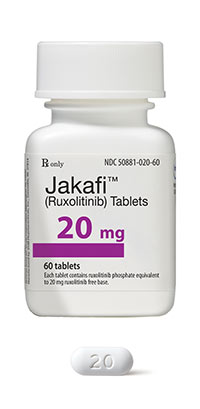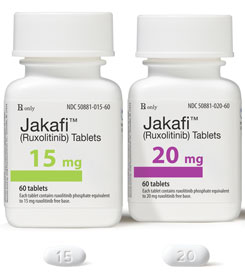近日,Incyte公司的骨髓纤维化治疗药物Jakafi(ruxolitinib)获得美国食品药品管理局(FDA)批准。Jakafi是治疗中高风险骨髓纤维化的JAK抑制剂,也是FDA批准的第一个骨髓纤维化治疗药物。
骨髓纤维化是一种罕见的、威胁生命的血液癌症,主要病理特征是骨髓造血功能衰竭、脾脏肿大。症状包括疲劳、盗汗、皮肤瘙痒、生活质量差、体重减轻、生命缩短。美国骨髓纤维化患者约有16000~18500人。
Jakafi获得批准是基于两项Ⅲ期临床试验(一项由Incyte公司自主研究,另一项与其合作伙伴诺华合作完成),528例患者参与了该药的安全性和有效性评价研究。研究分为3组:Jakafi组、安慰剂组(糖丸)和目前最佳疗法(化疗药物羟基脲或糖皮质激素)组。
结果显示,与安慰剂组和目前最佳疗法组相比,Jakafi组50%以上患者肿大的脾脏至少缩小了35%。同样,与安慰剂组相比,接受Jakafi治疗的大部分患者观察到的骨髓纤维化相关症状(包括腹部不适、盗汗、瘙痒、肌肉和骨骼疼痛)减轻50%以上。
Jakafi治疗组报告的最严重的副作用包括血小板水平低(血小板减少症)、贫血、乏力、腹泻、气短(呼吸困难)、头痛、头晕和恶心。
JAKAFI™ (ruxolitinib)片
美国初始批准:2011
适应证和用途
Jakafi是一种激酶抑制剂适用于治疗中间或高危骨髓纤维化, 包括原发性骨髓纤维化,真性红细胞增多症后骨髓纤维化和原发性血小板增多症后骨髓纤维化患者. (1)
剂量和给药方法
(1)对血小板计数大于200/μL患者,Jakafi的开始剂量是20 mg口服每天2次给药,而对血小板计数100/μL和200/μL间患者15 mg每天2次。 (2.1)
(2)起始用Jakafi治疗前进行完全血细胞计数。监视完全血细胞计数s 每2至4周直至剂量稳定化,,和然后当临床指示。对血小板计数减低调整剂量。(2.1) (2.2)
(3)根据反应增加剂量和因推荐至最大每天2次25 mg。如脾脏无减小或症状无改善6个月后终止。(2.3)
剂型和规格
片:5 mg,10 mg,15 mg,20 mg和25 mg。(3)
禁忌证
无。(4)
警告和注意事项
(1)可能发生血小板计数减低,贫血和中性粒细胞减少。用减低剂量,或中断或输血处理。(5.1)
(2)评估患者感染的体征和症状和及时开始适当治疗。开始用Jakafi治疗前严重感染应已解决。(5.2)
不良反应
最常见血液学不良反应(发生率 > 20%)是血小板计数减低和贫血。最常见非血液学不良反应(发生率 >10%) 是瘀斑, 眩晕和头痛。(6.1)
药物相互作用
(1)强CYP3A4抑制剂:对血小板计数大于或等于100/μL患者减低Jakafi开始剂量至10 mg每天2次和同时强CYP3A4抑制剂。血小板计数小于100/μL患者中避免使用。(2.4) (7.1)
特殊人群中使用
(1)肾受损:对中度(CrCl 30-59 mL/min)或严重肾受损(CrCl 15-29 mL/min)和血小板计数间100/μL和150 X 109/L患者Jakafi开始剂量减低至10 mg每天2次。终末肾病(CrCl 小于15 mL/min)不需要透析患者中和有中度或严重肾受损和血小板计数小于100/μL患者避免使用。(2.5) (8.6)
(2)肝受损:对任何程度肝受损和血小板计数100/μL和150/μL间患者Jakafi开始剂量减低至10 mg每天2次。肝受损与血小板计数小于100/μL患者避免使用。(2.5) (8.7)
(3)哺乳母亲: 终止哺乳或终止药物考虑药物对母亲的重要性。(8.3)
 |
Manufacturer:
Incyte Corporation
Pharmacological Class:
Kinase inhibitor.
Active Ingredient(s):
Ruxolitinib 5mg, 10mg, 15mg, 20mg, 25mg; tabs.
Indication(s):
Treatment of intermediate or high-risk myelofibrosis, including primary myelofibrosis, post-polycythemia vera myelofibrosis and post-essential thrombocythemia myelofibrosis.
Pharmacology:
Ruxolitinib inhibits Janus Associated Kinases (JAKs) JAK1 and JAK2, which mediate the signaling of a number of cytokines and growth factors that are important for hematopoiesis and immune function.
Clinical Trials:
The efficacy of Jakafi was evaluated in two clinical trials in patients with myelofibrosis. The starting dose was based on platelet count. Patients with a platelet count between 100–200X109/L were started on Jakafi 15mg twice daily, while patients with a platelet count >200X109/L were started on Jakafi 20mg twice daily. Doses were subsequently individualized based on tolerability and efficacy; maximum doses were 20mg twice daily if platelet counts were between 100 to ≤125X109/L, 10mg twice daily if platelet counts were between 75 to ≤100X109/L, and 5mg twice daily if platelet counts were between 50 to ≤75X109/L.
At primary endpoint, a significantly larger proportion of patients in the Jakafi group achieved a 35% or greater reduction in spleen volume from baseline in both studies (as compared to placebo in Study 1, and as compared to best available therapy in Study 2). A similar proportion of patients in the Jakafi group achieved a ≥50% reduction in palpable spleen length.
Legal Classification:
Rx
Adults:
Doses may be given by NG tube if unable to swallow tabs. Platelets >200X109/L: initially 20mg twice daily. Platelets 100–200X109/L: initially 15mg twice daily. May increase doses by 5mg twice daily to a max of 25mg twice daily; do not increase during the first 4wks of therapy and not more frequently than every 2wks. Discontinue treatment after 6mos if no reduction in spleen size or symptom improvement. Interrupt treatment if platelets <50X109/L. May restart or increase after recovery of platelets (see literature for max allowable restarting doses). Consider dose reductions if platelets decrease but remain >50X109/L (see literature). Concomitant strong CYP3A4 inhibitors: initially 10mg twice daily if platelets ≥100X109/L; if platelets <100X109/L: avoid. Moderate or severe renal impairment (CrCl 15–59mL/min) and platelets between 100–150X109/L: initially 10mg twice daily.
Children:
Not established.
Warnings/Precautions:
Monitor for thrombocytopenia, anemia, neutropenia; withhold or reduce dose if occur. Obtain CBC and platelets before initiating therapy, every 2–4 weeks until doses are stabilized, and then as clinically indicated. Risk of serious bacterial, mycobacterial, fungal, and viral infections; evaluate and treat if signs/symptoms occur. Confirm resolution of active infections before starting. Renal or hepatic impairment. Pregnancy (Cat. C). Nursing mothers: not recommended.
Interaction(s):
Potentiated by strong CYP3A4 inhibitors (eg, boceprevir, clarithromycin, conivaptan, grapefruit juice, indinavir, itraconazole, ketoconazole, lopinavir/ritonavir, nefazodone, nelfinavir, posaconazole, ritonavir, saquinavir, telaprevir, telithromycin, voriconazole) and mild or moderate CYP3A4 inhibitors (eg, erythromycin). Antagonized by CYP3A4 inducers (eg, rifampin).
Adverse Reaction(s):
Thrombocytopenia, anemia, neutropenia, bruising, dizziness, headache, UTIs, weight gain, flatulence, herpes zoster.
How Supplied:
Tabs—60



